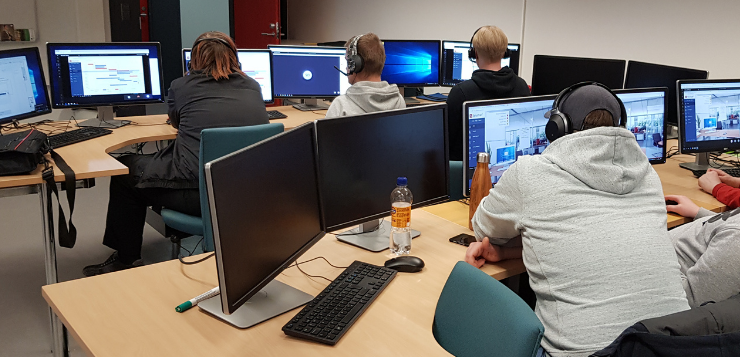The English-language ICT project module for the Degree Programme in Business Information Technology was carried out in spring 2021. The teachers of the module – Mirlinda Kosova-Alija and Erkki Laine – had divided the students into teams of four, with each group containing both full-time and part-time students as well as exchange students. The assignments for the projects were received from actual client companies via Turo Nylund of Sovelluskontti Oy. The module project lasted eight weeks, the first and last of which were used for initiating and finalising the project, meaning that the actual project working time was about one and a half months. This article is written by Lotta Linko, Quality Manager of HAMK and it is originally published in HAMK’s Quality Newsletter.
Students managed their own work within the planned framework
Olli Nokkonen is a full-time student who focused on the business client-initiated ICT project without having any other simultaneous courses or commitments. ‘We were given the framework, including the timetable, our team and the goals for the work, but within these parameters we managed the entire project ourselves. We started by contacting the company and making a project agreement which delimited our work. We studied the specs delivered to us and started to think about how to carry out the project. At the first meeting with the company, we defined in more detail the project and what we would be doing, and after that we were basically given free rein.’
The student team met with the company once a week. In these meetings, the project’s progress was presented, the results evaluated, and any necessary corrections were made. All team members and representatives of the company participated in the meetings, and a few times the module teacher also participated in monitoring the process, while not commenting on the content itself. There were separate supervision sessions with the teacher, and the progress of the project was also presented to other teams in the same module. The resulting code produced by the team was handed over to the client at the end of the module, and during the last week the students completed a project report together with the accompanying feedback.
Project benefits varied between the students
‘Team work, project work, learning from other group members, workplace contacts, English as a working language, developing areas of competence, new tools…’ Nokkonen says, listing the benefits of the ICT project for a full-time student.
Miikka Mörö, who is studying alongside his work, was in different group and carried out the project work for a different client, but the course still had the same framework. For a part-time student, the project brought different kinds of benefits. ‘I have past experience of doing project work in the workplace, and the substance of this project was quite similar to what I do in my day job. On the whole, however, the project was a refreshing change to my everyday work and an excellent opportunity to share my workplace competence with others. When working in a team, you can get to know other people, learn from others, and see things from perspectives different to those you are used to in your everyday work. Perhaps the most challenging part of this project has been fitting together our different calendars when timetabling project meetings,’ Mörö says with a laugh.
Risto Partanen is also a part-time student, and one with more than 10 years of experience in the field. He has also reflected on the direct benefits of the ICT project for his own work. ‘It was a good idea to refresh my understanding of project management theory and to compare it with the even more agile practices of real working life.’
Students would have more to offer
Partanen goes on to reflect on the benefits of the project from his position as an employer representative. ‘A module project would benefit the employer directly if the student could do the project on a topic useful for their own employer, but organised so that the project group would consist entirely of students. This would bring visibility in the workplace and make use of free student resources for a useful project. In addition, the student in whose workplace the project would be carried out could introduce their field and share competence from that sector with other project group members,’ Partanen suggests.
‘A second way to utilise students that are engaged in working life would be for them to present their own job and workplace to the other students and to the teachers as well. A factory tour or demonstration of different working tasks in an actual work environment, for example, would certainly open people’s eyes to what is done and how in different workplaces. For younger students, this would certainly be a new experience. Teachers, on the other hand, would get a picture of what is done in certain work tasks and, at the same time, would in practice see the competence of their own students in real working environments. At the same time, of course, the higher education institution gains visibility in the workplace,’ Partanen suggests.
The higher education institution must make clear and accessible what they have to offer
From the employer’s point of view, Mörö sees the possible challenges of the student project to be its short duration and the difficulty of fitting it into the company’s business cycles; the benefits, on the other hand, are the fresh thinking and extra labour. ‘When the assignment is well-defined and the topic is enjoyable for the students and useful for the company, excellent groundwork can be laid for actual production-related activities.’
The benefits of student work must be clearly described to employers and the process for ordering project work made easy. According to Mörö, the higher education institution should take the initiative in this. ‘When there is a particular situation and need, people always first use their networks and other resources they know of. The company does not have time for exploring new avenues, but instead wants to get as direct and clear a connection as possible with a person or organisation that is familiar with the need, knows what’s on offer, suggests a solution and takes things forward. In this context, a well-functioning portal service is also a better option than be transferred and bounced around from one department to the next. What’s important is that things move forward and the customer is clear on the direction being taken,’ Mörö explains.
Text: Lotta Linko, Quality Manager, HAMK




